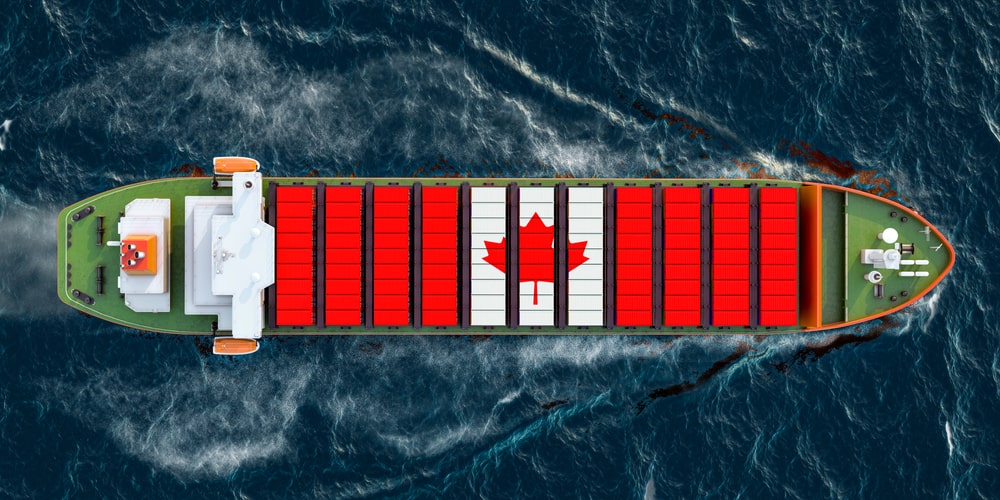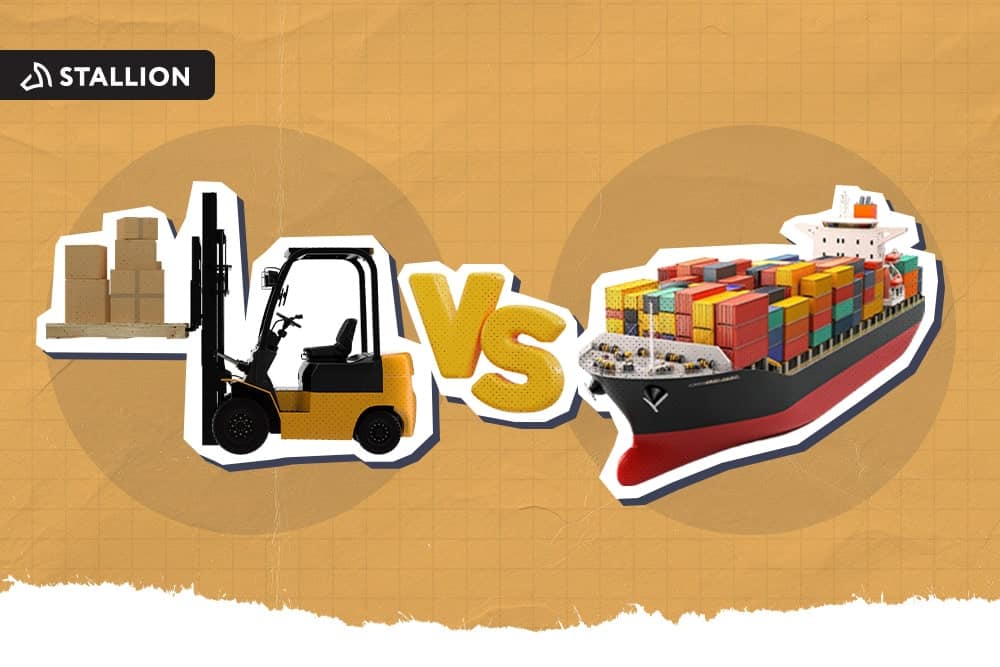
With Canada's diverse landscapes and sprawling geography, the cost of shipping in Canada has long been a subject of concern and curiosity. This article will answer the question, "Why is shipping so expensive in Canada?" discussing the factors contributing to the elevated shipping costs in the country.
From the challenges posed by the vast distances between regions to the impact of international trade agreements on shipping charges, this seeks to unravel the complexities that make shipping a costly affair in the Canadian context.
Canada has higher shipping costs than other countries due to the country's vast geography and dispersed population. The great distances between regions increase transportation expenses. Additionally, international trade agreements can impact shipping fees. Limited competition in certain areas and the need for specialized services increase shipping charges and contribute to the overall cost.
High operating costs for carriers, including fuel and labour, also play a role. To handle these challenges, consider optimizing packaging, negotiating with carriers, and exploring regional partnerships. Understanding these factors can empower Canadian sellers to make informed decisions and manage shipping expenses more effectively in the country's unique logistical landscape.

Here are the shipping costs for each mail service when shipping a small package (weighing up to 500 grams) within Canada:
Shipping Service | Starting Price | Delivery Time |
Canada Post Regular Parcel | CAD 12.99 | 2-9 business days |
FedEx SmartPost | CAD 14.99 | 2-8 business days |
FedEx Ground | CAD 21.95 | 1-7 business days |
DHL eCommerce | CAD 14.99 | 2-5 business days |
Purolator Ground | CAD 14.95 | 1-7 business days |
UPS Ground | CAD 19.95 | 1-5 business days |
Your best service will depend on your specific shipping needs and budget. If unsure which service to choose, you can compare rates and delivery times online or contact the provider’s customer support hotline.

Understanding the elements influencing costs can shed light on the key determinants shaping the pricing landscape of shipping. Let's go through the logistical complexities and economic variables playing an important role in defining the bottom line of shipping costs, providing valuable insights for businesses and consumers alike.
Canada's vast landmass and expansive geography significantly impact shipping expenses for sellers. The long distances between regions contribute to higher transportation costs, as goods have to cover large areas. This geographical challenge complicates logistics, making shipping more expensive for businesses nationwide.
The vast size and scattered population throughout Canada is a major factor in the rising cost of shipping for sellers. Sparse population distribution results in fewer delivery destinations per route, increasing the per-unit cost of transportation. This logistical challenge adds to the shipping expenses for businesses catering to diverse and scattered consumer bases.
Extreme weather conditions in Canada significantly impact shipping expenses for sellers. Harsh winters and unpredictable weather patterns during winter months can disrupt transportation, leading to delays, increased fuel consumption, and additional handling costs. Adapting logistics to weather challenges is crucial for managing expenses and ensuring reliable delivery services in the Canadian climate.
Limited transportation infrastructure in Canada poses a challenge for sellers, impacting shipping expenses. Insufficient infrastructure can lead to bottlenecks, slower transit times, and increased costs for alternative routes.
In remote locations, the need for more efficient transportation options raises the overall expense of reaching customers. To address these obstacles, sellers must strategize logistics, consider regional partnerships, and leverage available infrastructure to optimize shipping expenses in the face of limited transportation resources.
Most remote areas and locations with access difficulties have lower population density. Thus, serving customers in these regions involves higher costs due to longer delivery routes, limited transportation options, and additional logistical hurdles.
Getting around in difficult terrain and addressing accessibility issues can contribute to increased fuel consumption and extended transit times. Sellers must account for these aspects to manage expenses effectively, optimizing their logistical strategies to provide reliable customer service in remote locations.
Customs procedures and government paperwork significantly impact shipping expenses for Canadian sellers. The intricate process of clearing goods through customs, including documentation and compliance, adds both time and costs to shipments.
Delays in customs clearance result in increased storage fees and potential penalties. Understanding the complexities of international trade and regulations is crucial for sellers, emphasizing the need for meticulous paperwork to streamline customs procedures and minimize expenses associated with clearance delays.
Pricing plans must account for the increased expenses incurred by enforcing and paying these taxes on goods crossing borders. Sellers need to comprehend tariff systems and navigate the complexities of international trade agreements to estimate and manage costs effectively. Understanding these monetary factors is crucial for efficient cost control and competitiveness in the global market.
Fluctuations in fuel costs influence transportation expenses, affecting the overall logistics budget. Higher fuel prices increase carriers' operational costs, often passed on to sellers. Monitoring and adapting to these changes are crucial for effective cost management in the shipping process.

Discover practical strategies to optimize logistics, mitigate geographical challenges, and navigate regulatory complexities, empowering you to streamline operations, save money, and enhance your bottom line in the dynamic world of eCommerce.
Canadian sellers can strategically negotiate with shipping companies like Canada Post, FedEx, and others to effectively manage shipping expenses. Begin by setting international rates and consolidating shipments to negotiate volume-based discounts—leverage competition by obtaining quotes from multiple carriers and using them as bargaining tools.
Establish a long-term partnership with the postal service and private shipping companies to secure favourable shipping rates. Explore loyalty programs and incentives by carriers. Regularly review and renegotiate contracts based on shipping volumes and market changes, ensuring ongoing cost optimization for your business.
Utilizing regional fulfillment centres strategically positions Canadian sellers to manage shipping expenses efficiently. Storing inventory closer to key customer bases minimizes shipping distances, reducing transportation. Regional fulfillment enables faster delivery, enhancing customer satisfaction and lowering shipping rates. Additionally, it streamlines customs procedures, optimizing international shipping.

Canadian sellers implement efficient packaging strategies to manage parcel rates by optimizing dimensions and materials. Right-sized packaging minimizes dimensional weight charges, reducing costs. A light package maintains compliance with weight-based pricing structures and avoids putting too much weight on the package. Thus, consider utilizing lightweight materials to ensure that you meet this standard.
Implementing eco-friendly packaging not only appeals to environmentally conscious consumers but can also reduce overall shipping expenses. Streamlining packaging processes ensures efficiency, minimizes waste, and contributes to a cost-effective shipping strategy for Canadian sellers.
Implementing advanced logistics software helps optimize routes, reducing fuel costs and improving delivery efficiency. Integrating eCommerce platforms with shipping management systems enhances order processing, minimizing errors. Real-time tracking and analytics enable data-driven decision-making, while automated inventory management prevents overstocking.

Stallion emerges as a strategic partner for Canadian sellers seeking affordable and efficient shipping solutions within Canada and beyond its borders.
Stallion is a Canadian eCommerce shipping company that provides discounted postage rates for shipping within Canada, to the United States, and internationally. Their competitive international rates allow sellers to ship to over 200 countries and compete on price with local sellers.
Thousands of online sellers in Canada trust Stallion. Their commitment to negotiating lower rates with major carriers and cutting-edge technology integration empowers sellers to optimize logistics, manage costs, and deliver a seamless customer experience.
As Canadian sellers aim to extend their reach globally, Stallion is a reliable partner, ensuring that products reach destinations affordably and efficiently.
Aman looks after the content marketing department at Stallion Express. He is passionate about helping businesses grow by providing informative and up-to-date trends in the eCommerce industry. Outside the office, you can find him on the soccer field cheering on Real Madrid.



Can our fellow Torontonians relate?
-
#smallbusiness #business #entrepreneur #socialmedia #shipping #ecommerce #canadianecommerce #shopify #poshmark #b2b #saas #etsy #ebay #canada #canadiansmallbusiness #shoplocalcanada #entrepreneur
#toronto

Here’s your quick hassle free shipping from 🇨🇦 to 🇺🇸 as a business owner!
-
Any questions?! Leave them 👇🏻 and save this video so you don’t forget!
-
#smallbusiness #business #entrepreneur #socialmedia #shipping #ecommerce #canadianecommerce #shopify #poshmark #b2b #saas #etsy #ebay #canada #canadiansmallbusiness #shoplocalcanada #entrepreneur

Meet @drinkbenny a 🇨🇦 female founded energy drink brand! Instead of focusing on their products, they’re taking a unique approach by hosting in person events in different Canadian cities to offer an experience for their community 🧡
-
What are your thoughts on in person events? 💭
-
#smallbusiness #business #entrepreneur #socialmedia #shipping #ecommerce #canadianecommerce #shopify #poshmark #b2b #saas #etsy #ebay #canada #canadiansmallbusiness #shoplocalcanada #entrepreneur

Do you know the difference between DDU and DDP when shipping internationally 🌏 ?
-
Questions? Leave them below! 👇🏻
-
#smallbusiness #business #entrepreneur #socialmedia #shipping #ecommerce #canadianecommerce #shopify #poshmark #b2b #saas #etsy #ebay #canada #canadiansmallbusiness #shoplocalcanada #entrepreneur

Here’s a quick hack to save time from choosing multiple postage options
↪️ Turn on the lowest postage rate automation to save you time!
-
Questions? Leave them below! 👇🏻
-
#smallbusiness #business #entrepreneur #socialmedia #shipping #ecommerce #canadianecommerce #shopify #poshmark #b2b #saas #etsy #ebay #canada #canadiansmallbusiness #shoplocalcanada #entrepreneur
